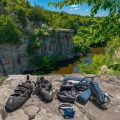1. Understanding the Demands of Multi-Day Hiking
What Makes Multi-Day Hiking Different?
If you’ve ever spent a whole weekend—or even a week—trekking through America’s national parks, you know it’s nothing like a day hike. Whether you’re climbing the rugged switchbacks of the Pacific Crest Trail, navigating the humid forests of the Appalachian Trail, or crossing arid stretches in the Grand Canyon, every terrain throws unique challenges your way. Multi-day hiking isn’t just about putting one foot in front of the other; it’s a full-body and mind adventure that pushes your endurance to new levels.
The Physical Demands
Your body is working overtime on multi-day treks: carrying a loaded backpack, adjusting to changes in elevation, and dealing with unpredictable weather. You burn more calories per hour than you might expect—often upwards of 3,000-5,000 calories each day. Muscles get sore, joints take a beating, and energy levels can spike and crash throughout the day.
| Physical Challenge | Description | Common Terrain |
|---|---|---|
| Steep Ascents/Descents | High energy expenditure, increased muscle fatigue | Rocky mountains (Sierra Nevada, Rockies) |
| Long Mileage Days | Sustained endurance required over many hours | PCT, AT, CDT sections |
| Variable Weather | Hydration and temperature management become key | Desert (Arizona), high alpine (Colorado) |
| Heavy Packs | Extra strain on back and legs; higher calorie needs | All terrains with overnight gear |
The Mental Game
Mental fatigue is real out there. Long days on the trail test your patience and grit. Decision fatigue—from choosing routes to rationing food—can creep up fast. The isolation or monotony of certain stretches can challenge even seasoned hikers’ focus and morale.
Why Specialized Nutrition Matters
This is where nutrition comes in as your secret weapon—not just for fueling muscles but also for keeping your brain sharp and your mood steady. Unlike casual hikes or single-day outings, multi-day adventures require thoughtful meal planning for consistent energy, quicker recovery at camp, and maintaining hydration even when water sources are scarce or unreliable.
How Nutrition Impacts Your Hike:
| Nutritional Focus | Benefit on Trail | Real-Life Example |
|---|---|---|
| Carbohydrates & Protein Balance | Sustained energy + muscle repair overnight | Pasta dinners paired with jerky or beans at camp |
| Electrolyte Management | Prevents cramping + supports hydration in heat/humidity | Adding electrolyte tablets to water in Utah’s desert trails |
| Healthy Fats | Dense calories for long mileage days without heavy packs | Nuts, nut butters, olive oil packets for lunch breaks on the go |
| Mental Boosters (Omega-3s, B Vitamins) | Mood stability + sharper decision-making under stress | Tuna packets, trail mix with seeds during tough climbs in Vermont woods |
Understanding these physical and mental demands—and how nutrition can help meet them—is step one toward gearing up for your next big multi-day hiking adventure across America’s wild places.
2. Macronutrients: Fuel for the Trail
Understanding Carbs, Proteins, and Fats for Multi-Day Hikes
When youre training for a multi-day hiking adventure, your body needs the right kind of fuel to keep going day after day. That’s where macronutrients—carbohydrates, proteins, and fats—come in. Each one plays a unique role in helping you power up those steep climbs, recover after long days, and stay energized from sunrise to sunset.
Carbohydrates: The Body’s Main Energy Source
Carbs are your primary source of quick energy during endurance activities like hiking. Your muscles store carbs as glycogen, which is what you tap into when you’re trekking up a hill or pushing through the last few miles of the day. Without enough carbs, you might find yourself running out of steam sooner than expected.
- Sources: Oatmeal, rice, tortillas, dried fruit, granola bars
- Tip: Aim to include some form of carbohydrate in every meal and snack on the trail.
Protein: Repair and Recovery
While protein isn’t your main energy source during exercise, it’s essential for muscle repair and recovery—especially when you’re doing several days of hiking back-to-back. Eating enough protein helps your muscles bounce back overnight so you can hit the trail again the next morning without feeling completely wiped out.
- Sources: Jerky, tuna packets, nut butters, hard cheeses, protein bars
- Tip: Try to include protein-rich foods in both your main meals and snacks to spread intake throughout the day.
Fats: Long-Lasting Fuel
Fats take longer to digest than carbs but provide steady, slow-burning energy—perfect for those long days when you’re hiking at a moderate pace for hours on end. Fats also help keep you full and satisfied between meals.
- Sources: Trail mix with nuts and seeds, olive oil packets, nut butters, dark chocolate
- Tip: Mix healthy fats into your meals or add them to snacks for extra staying power.
Balancing Macronutrients on the Trail
The best way to balance carbs, protein, and fat is to combine them at each meal and snack. Here’s a simple table to show what that might look like for a typical day on the trail:
| Meal/Snack | Main Carb Source | Main Protein Source | Main Fat Source |
|---|---|---|---|
| Breakfast | Instant oatmeal with dried fruit | Nuts or powdered milk added in | Pepitas (pumpkin seeds) |
| Morning Snack | Dried mango slices | Packed jerky | Nuts or nut butter packet |
| Lunch | Tortilla wrap with rice or couscous | Tuna or chicken pouch | Mayo or olive oil packet mixed in |
| Afternoon Snack | Granola bar | Cheese stick or hard cheese slices | Sliced almonds mixed in bar or eaten on side |
| Dinner | Instant mashed potatoes or pasta side pack | Shelf-stable sausage or beans (if available) | Add olive oil or cheese shreds for richness |
Practical Strategies for Endurance Hiking Nutrition
- Plan ahead: Pre-pack balanced snacks so you don’t have to think about nutrition when you’re tired.
- Aim for variety: Mixing up your carb, protein, and fat sources keeps meals interesting and ensures a range of nutrients.
- Listen to your body: If you start feeling sluggish or extra sore, it might be time to tweak your macros—add more carbs if you need quick energy or bump up protein if recovery feels slow.
The right mix of carbohydrates, proteins, and fats can make all the difference when training for—and crushing—a multi-day hike. With some planning and smart choices, youll have the energy and stamina needed to enjoy every mile.

3. Micronutrients and Hydration Essentials
Key Micronutrients for Endurance Hiking
When you’re training for a multi-day hike, it’s easy to focus on calories and protein, but micronutrients—those vitamins and minerals you need in smaller amounts—play a major role in keeping your body strong, preventing fatigue, and avoiding muscle cramps. Here are the essentials every hiker should know about:
| Micronutrient | Main Benefits | Good Sources (Trail-Friendly) |
|---|---|---|
| Sodium & Potassium (Electrolytes) | Regulate fluid balance; prevent muscle cramping | Electrolyte tablets, salted nuts, dried fruit (like apricots or bananas), jerky |
| Magnesium | Supports muscle function; reduces risk of cramps | Pumpkin seeds, trail mix with dark chocolate, whole grain crackers |
| Calcium | Bone health; aids muscle contraction | Instant oatmeal packets with powdered milk, cheese snacks, fortified plant milks |
| Iron | Delivers oxygen to muscles; prevents fatigue | Dried beef or turkey, lentil soup packets, energy bars with nuts/seeds |
| B Vitamins (especially B6 & B12) | Energy metabolism; helps convert food into fuel | Whole grain granola bars, nut butter packs, tuna pouches |
Electrolytes: Your Trail Sidekicks
If you’ve ever felt wiped out or battled a charley horse during a long hike, lack of electrolytes could be the culprit. When you sweat—especially on hot days—you lose sodium and potassium fast. Carrying electrolyte drink mixes or tabs can make a real difference on multi-day adventures.
Smart Hydration for Every U.S. Climate
The right hydration strategy depends on where you’re hiking in the States. Here’s a quick breakdown:
| Climate Type | Hydration Tips |
|---|---|
| Deserts (e.g., Arizona, Utah) | – Drink small amounts frequently instead of gulping large amounts at once. – Use insulated bottles to keep water cool. – Add extra electrolytes to help retain fluids. – Aim for at least one liter per hour of activity. |
| Mountains (e.g., Rockies, Sierra Nevada) | – Altitude increases dehydration risk—drink more than you think you need. – Pack a lightweight filter or purifier for stream refills. – Monitor urine color: pale yellow is ideal. |
| Humid Forests (e.g., Appalachians, Pacific Northwest) | – You’ll still sweat even if you don’t feel thirsty. – Schedule water breaks every hour. – Consider low-sugar electrolyte drinks to replace lost salts. |
Quick Tips for Staying Hydrated:
- Start hydrated: Drink plenty before hitting the trail.
- Camel up at water sources: Drink extra when refilling if water is scarce ahead.
- Add flavor: If plain water gets boring, try flavor enhancers with added vitamins/electrolytes.
- Pace yourself: Don’t wait until you’re thirsty—it’s often too late by then.
Your Takeaway:
A few smart choices with micronutrients and hydration can be the difference between powering through those last miles or battling unwanted cramps and exhaustion. Keep these essentials handy as part of your adventure toolkit!
4. Pre-Hike Nutrition: Laying the Foundation
If you’re gearing up for a multi-day hiking trip, what you eat in the days leading up to your adventure can make a huge difference in how you feel on the trail. Think of your body as a backpack—if you fill it with the right stuff before heading out, you’ll be ready for whatever comes your way. Here’s how to set yourself up for success with smart pre-hike meal planning and carb-loading.
Why Pre-Hike Nutrition Matters
Your muscles store energy in the form of glycogen, which mainly comes from carbohydrates. When you’re out hiking for several days, those stores are your main fuel source. If they run low, you’ll start to feel sluggish and your recovery will slow down. The goal is to top off your glycogen tank before you even step onto the trail.
Carb-Loading: A Simple Approach
You don’t need to eat mountains of pasta or bread like an Olympic athlete, but a modest increase in carbs 2-3 days before your hike helps maximize energy reserves. Focus on wholesome, familiar foods that won’t upset your stomach.
| Meal | Carb Examples | Tips |
|---|---|---|
| Breakfast | Oatmeal with fruit, whole grain toast, pancakes | Add nut butter or eggs for sustained energy |
| Lunch | Burrito bowl with rice and beans, turkey sandwich on wheat bread, quinoa salad | Include lean protein and veggies for balance |
| Dinner | Pasta with tomato sauce and grilled chicken, baked sweet potatoes, brown rice stir-fry | Keep sauces light to avoid GI issues |
| Snacks | Dried fruit, granola bars, pretzels, bananas | Avoid high-fat or super-sugary options |
Hydration Is Part of the Plan
Start hydrating at least a day before your hike. Aim for water or electrolyte drinks rather than soda or energy drinks. Well-hydrated muscles perform better and are less prone to cramps.
Avoid Last-Minute Surprises
This isn’t the time to try new foods or experimental diets. Stick to meals that have worked well for you during training hikes. Your digestive system will thank you once you hit mile five on day one.
Key Takeaways for Pre-Hike Nutrition:
- Increase carbohydrate intake 2-3 days before starting your hike.
- Balance carbs with protein and healthy fats for sustained energy.
- Stay hydrated—don’t wait until the morning of your hike.
- Avoid unfamiliar foods and anything that has previously upset your stomach.
- If you drink coffee regularly, keep it in your routine to prevent caffeine withdrawal headaches on the trail.
5. On-Trail Eating: What Works in the Backcountry
When you’re training for multi-day hiking adventures, what you eat on the trail can make or break your experience. It’s all about finding foods that are lightweight, nutrient-dense, and easy to prepare—even when your “kitchen” is a camp stove or a log next to the trail. Here’s how to pack smart and fuel up like a seasoned American hiker.
Smart Packing: Choosing Nutrient-Dense Snacks and Meals
The key is to focus on foods that give you the most nutrition per ounce. Think protein, healthy fats, complex carbs, and essential vitamins and minerals. You want snacks and meals that keep your energy up without weighing down your pack.
Go-To American Outdoor Staples
| Food | Why It Works | How to Use It |
|---|---|---|
| Trail Mix (Gorp) | Packed with healthy fats, protein, and quick carbs; classic American hiking fuel. | Eat by the handful for energy boosts between meals. |
| Jerky (Beef/Turkey/Vegan) | High in protein, shelf-stable, savory satisfaction. | Snack on during breaks or add to instant noodles for extra protein. |
| Nut Butter Packets | Calorie-dense, versatile, and easy to squeeze out on-the-go. | Spread on tortillas or squeeze straight into oatmeal. |
| Tortillas/Flatbreads | Lighter than bread, don’t crush easily, multi-use carb source. | Wrap around jerky, cheese, or nut butter for quick meals. |
| Dried Fruit | Naturally sweet energy boost plus fiber and micronutrients. | Add to trail mix or oatmeal; eat alone for a sugar lift. |
| Instant Oatmeal Packets | Lightweight breakfast staple loaded with carbs and fiber. | Add hot water; top with nuts or dried fruit for more calories. |
| Dehydrated Meals | No-fuss dinner after a long day; just add hot water. | Choose options with whole grains and veggies for balanced nutrition. |
| Candy Bars/Energy Bars | Satisfying treats with fast-acting sugars and sometimes protein. | A morale boost at the end of a tough climb or as dessert. |
| Couscous/Instant Rice | Cooks fast with minimal fuel; pairs well with seasoning packets or tuna pouches. | Bases for hearty dinners with added protein and veggies. |
| Tuna/Chicken Pouches | Shelf-stable lean protein option; no draining required. | Add to tortillas, rice, or eat right from the pouch. |
Packing Tips: Keep It Simple and Practical
- Pre-portion everything: Bag individual servings so you can grab-and-go without thinking twice about portions or waste.
- Avoid heavy packaging: Repackage food in zip-top bags to reduce weight and trash on the trail.
- Diversify flavors: Bring both sweet and savory options—taste fatigue is real after several days outside!
- Add electrolytes: Pack electrolyte drink mixes to help replenish what you lose sweating it out over miles of trail.
Tried-and-True Meal Combos for Hikers
| Meal Time | Simple Combo Idea |
|---|---|
| Breakfast | Instant oatmeal + peanut butter + dried cranberries + instant coffee packet |
| Lunch | Tortilla wrap + tuna pouch + hot sauce packet + handful of trail mix on the side |
| Dinner | Couscous + dehydrated veggies + jerky bits + olive oil drizzle (for extra calories) |
The Bottom Line: Test Before You Trek
The best backcountry nutrition plan is one you’ve tested during training hikes. Try different foods and combos before your big trip so you know what works for your body—and what keeps your spirits high when you’re miles from the nearest road. Your food is your fuel, so treat it like an essential part of your adventure kit!
6. Post-Hike Recovery Nutrition
After completing a multi-day hiking adventure, your body needs targeted nutrition to bounce back faster, rebuild sore muscles, and get you ready for your next adventure. Here’s how to approach post-hike recovery using easy-to-find American grocery store options.
Why Recovery Nutrition Matters
Long hikes break down muscle tissue, deplete glycogen stores (your muscles energy reserve), and can leave you feeling wiped out. Smart post-hike nutrition helps:
- Speed up muscle repair and growth
- Replenish lost energy
- Reduce soreness and inflammation
- Restore hydration and essential minerals
What Your Body Needs After Hiking
| Nutrient | Role in Recovery | Easy Grocery Store Picks |
|---|---|---|
| Protein | Repairs and builds muscle fibers | Greek yogurt, rotisserie chicken, eggs, cottage cheese, protein shakes |
| Carbohydrates | Refills energy stores (glycogen) | Whole grain bread, bananas, brown rice, sweet potatoes, oatmeal |
| Electrolytes | Restores sodium, potassium, magnesium lost through sweat | Coconut water, sports drinks (like Gatorade), pickles, salted nuts, oranges |
| Healthy Fats | Aids absorption of vitamins & reduces inflammation | Avocado, olive oil, nut butters, trail mix with nuts/seeds |
| Antioxidants | Counters oxidative stress from long exertion | Berries (blueberries/strawberries), spinach, bell peppers, dark chocolate |
Sample Post-Hike Recovery Meal Ideas
- Bowl Meal: Brown rice or quinoa topped with grilled chicken or tofu, avocado slices, spinach, cherry tomatoes, and a drizzle of olive oil.
- Smoothie: Greek yogurt blended with frozen berries, banana, spinach, peanut butter, and a splash of coconut water.
- Pita Pocket: Whole wheat pita stuffed with tuna salad (use Greek yogurt instead of mayo), baby spinach, and sliced bell peppers.
- Savory Snack Plate: Hard-boiled eggs, whole grain crackers, string cheese, orange wedges, and a handful of roasted almonds.
Quick Tips for Faster Recovery
- Treat yourself within an hour: Try to eat a balanced meal or snack within 30-60 minutes after finishing your hike for best results.
- Stay hydrated: Keep drinking water or electrolyte-rich beverages throughout the day as your body continues to recover.
- Add anti-inflammatory foods: Turmeric tea or ginger shots can help ease soreness—look for them in the wellness section at many U.S. supermarkets.
- No need for fancy supplements: Regular grocery store staples offer everything you need for recovery—just focus on variety and balance!


